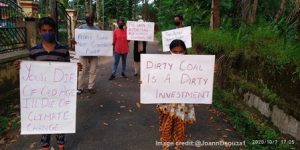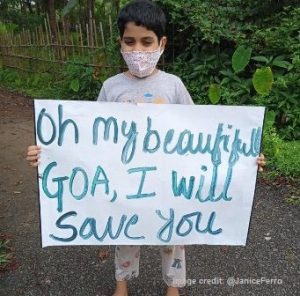‘Goyant Kollso Naka’: We Don’t Want Coal in Goa
Goans are protesting because they fear that these projects will not only destroy the wildlife parks, but will also choke them with coal pollution.
Goans are seen protesting since 1 November 2020 by blocking railway lines in the village of Chandol (South Goa). Recently around 200 anti-protestors gathered around the south  Goa police headquarters in Margao after the two leaders participating in the protest were summoned. They have been chanting the goal of “Goyant Kollso Naka” (we don’t want coal in Goa) unabated through the nights, beating drums, singings and dancing raising slogans to cease the government from their three mega projects which would deprecate the beauty of Goa.
Goa police headquarters in Margao after the two leaders participating in the protest were summoned. They have been chanting the goal of “Goyant Kollso Naka” (we don’t want coal in Goa) unabated through the nights, beating drums, singings and dancing raising slogans to cease the government from their three mega projects which would deprecate the beauty of Goa.
Goans have taken to roads when they realised about the recent three mega projects launched by the state government. During the lockdown a standing committee was formed by the National Board for Wildlife, under the chairmanship of Union Minister Prakash Javedkar. These projects talk about the clearance of 30 forests. Out of all these 30 projects, three have received approval.
The first project is about the doubling the railway tracksthat connect Mormugao port (Goa) with northern Karnataka. It is aimed at terminal capacity expansion of two births 5A and 6A with Jindal’s South West Port Limited, which aims to double the coal imports to 14 million tonnes. The Mormugao Port is the major port on the western coast with the history of 125 years. The Port has various mining regions in Goa as a result it is one of the premium iron ore exporting ports of the country. The project is proposing to double the tracks to increase the connectivity to ensure fast transport of key raw materials for the infrastructure-based industries.
The second project is for the expansion of National Highway 4-A. This highway in Belgaum in Karnataka to Goa is a four-lane highway. At the stretch the highway becomes narrow and the two-line connect which does not come under the definition of word highway. The reason being that before entering in Goa the road passes through the Western Ghats—a 1600 km mountain range. This range has been classified as the Global Biodiversity Hotspot as well as the UNESCO World Heritage Site. Covering less than 6 per cent of the country’s land, this place has itsone-third of plants and animals including endangered species.
The Ministry of Forests, Environment and Climate Change has approved clearance to 76 projects in July 2014.
Also Read : Baghjan Oil Leak and Blowout: Questions Remain
The third project is about the construction of new 400KV power transmission line. This transmission line connects Karnataka with Goa.It will work for the power generation projects located at Chhattisgarh. The transmission line will span the three districts of Uttara Kannada, Belagavi and Dharwad in Karnataka, and South Goa District in Goa. The line will start from Narendra village in Dharwad District and terminate at Xeldem village in Goa. The total length of the venture path in Karnataka is 77.64 km. Out of this, 31.8 km is within the wooded area, 6.61 km in Dandeli Wildlife Sanctuary and the rest is sales land. The project proposes to clear the 177 hectares of forest area.
 All these three projects require Bhagwan Mahavir Sanctuary and Mollem National Park to be cleared. If these projects are implemented that would cost the entire nation the loss of 170 hectares of land, falling of 59,000 tress. The claims made by locals are not limited to the issue of deforestation, but also the fear that Goa would soon transmit into a coal hub further destroying the pristine beauty of the state. Moreover, the loss that the wildlife is going to suffer is countless.
All these three projects require Bhagwan Mahavir Sanctuary and Mollem National Park to be cleared. If these projects are implemented that would cost the entire nation the loss of 170 hectares of land, falling of 59,000 tress. The claims made by locals are not limited to the issue of deforestation, but also the fear that Goa would soon transmit into a coal hub further destroying the pristine beauty of the state. Moreover, the loss that the wildlife is going to suffer is countless.
The government has constantly tried to justify the launch of projects. They are saying that it is very important project for the advancement of the state. They are also ensuring that the fear express by people is baseless, the state would not increase its coal export and Goa would not become a coal hub. The Chief Minister of Goa, Pramod Sawant, even made statements that the protests are not organised by locals, but by people from abroad. The environment minister for Goa, Nilesh Cabrel has came up with the assurance that Goa will not become any coal hub and there will not be any increase in the coal that is being imported in the state.
The government has put the Belagavi National Highway widening project on hold right now, but has said that 400kv transmission projects will be completed soon and not more than 13000 trees would be cut.
Also Read : Human Rights experts urge for Make In India and Skill India responsibly
People are protesting because they fear that these projects will not only destroy the wildlife parks, but will also choke them withcoal pollution. A study by National Institute of Oceanography has researched that mercury poisoning of oysters and the clams that are harvested in oceans has surrounded the ports. The protestors have blocked all the roads and railway lines against this decision and have made their motive very clear. They will not let Jindal South West (the largest coal exporter besides Adani and Sesa Sterlite groups destroy their land. While the government seems to justify the projects for the developmental reasons, the main stream media have also ignored the issue.
Environmentalists, locals and chunk of social media are concerned about the protection of biodiversity of Goa. The main issue that has come up after these protests is that is it justified to let go our environment destroyed for the development of our society? As per the Goal 15 of United Nations Sustainable Development Goals,we all need to ensure environmental sustainability for our upcoming generation. We need to integrate of principles of sustainable development into country’s policies and reverse the loss of environmental resources. It is up to we people to make an informed decision to balance any environmental loss vis-à-vis development.
(Slider Image credit: thegoan.net)
